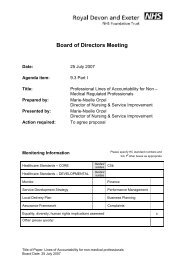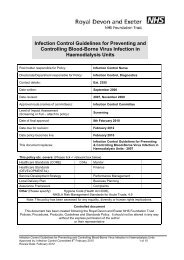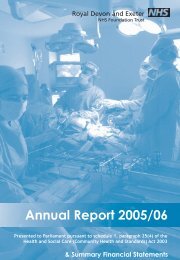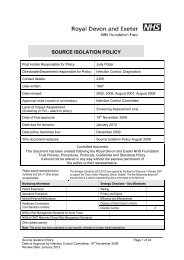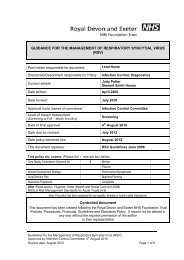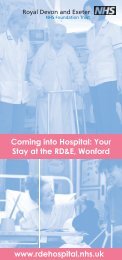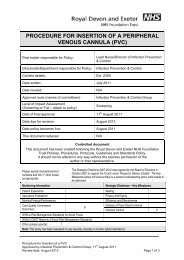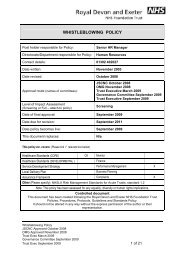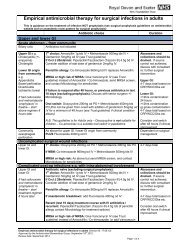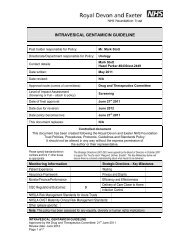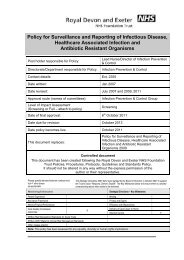Annual Report and Accounts 2012/13 - Royal Devon & Exeter Hospital
Annual Report and Accounts 2012/13 - Royal Devon & Exeter Hospital
Annual Report and Accounts 2012/13 - Royal Devon & Exeter Hospital
Create successful ePaper yourself
Turn your PDF publications into a flip-book with our unique Google optimized e-Paper software.
2. Progress on our<br />
<strong>2012</strong>/<strong>13</strong> Priorities<br />
<strong>Royal</strong> <strong>Devon</strong> <strong>and</strong> <strong>Exeter</strong> NHS Foundation Trust<br />
Quality <strong>Report</strong> <strong>2012</strong>/<strong>13</strong><br />
23<br />
CASE STUDY<br />
Patient Safety Thermometer<br />
The NHS safety thermometer is a tool<br />
developed <strong>and</strong> implemented nationally<br />
to measure ‘Harm Free Care’. ‘Harm<br />
free care’ is defined as the absence of<br />
four ‘harms’:<br />
• Pressure ulcers<br />
• Patient falls<br />
• Urinary tract infections in patients<br />
with a catheter<br />
• New venous thromboembolism<br />
(blood clots).<br />
The NHS is striving to provide ‘harm<br />
free care’ as these harms affect over<br />
200,000 people each year in Engl<strong>and</strong><br />
alone, leading to avoidable suffering<br />
<strong>and</strong> additional treatment for patients<br />
<strong>and</strong> a cost to the NHS of more than<br />
£400million.<br />
The <strong>Royal</strong> <strong>Devon</strong> <strong>and</strong> <strong>Exeter</strong> has<br />
extensive programmes of work tailored<br />
to each area to prevent these harms<br />
occurring to patients <strong>and</strong> has seen<br />
improvement in each one. On a single<br />
day each month, every patient in our<br />
care is reviewed by a matron or other<br />
senior nurse to identify if any of these<br />
harms have occurred at any point in<br />
their care. These spot audits provide<br />
our nursing leaders with a really good<br />
insight into the everyday st<strong>and</strong>ards of<br />
care across their wards.<br />
Some patients may have already come<br />
to harm before they arrived at the<br />
RD&E, for example they may have<br />
acquired a pressure ulcer at home or<br />
in another care setting. We therefore<br />
measure two indicators: ‘harm-free<br />
care’ for patients across their whole<br />
NHS journey, <strong>and</strong> ‘absence of new<br />
harm’ for patients directly in our care.<br />
Each month’s figures are reported<br />
to the Board in the ‘Ward to Board’<br />
report. They also act as an additional<br />
cross-check on our existing reporting<br />
procedures.<br />
Our overall performance for <strong>2012</strong>/<strong>13</strong><br />
was:<br />
• 95% harm-free care<br />
• 97% no new harm.<br />
Senior Matron, Anita Irwin, explains<br />
the difference that the safety<br />
thermometer has made – for patients<br />
<strong>and</strong> staff:<br />
“We’ve been running the safety<br />
thermometer programme for a year<br />
now <strong>and</strong> have found it’s a really useful<br />
addition to our care quality <strong>and</strong> safety<br />
toolkit.<br />
“It’s my role to co-ordinate the safety<br />
thermometer each month. On the<br />
second Tuesday of every month, I visit<br />
every area of the Trust, carrying out<br />
the audit <strong>and</strong> supporting the matrons<br />
in completing their database. If they<br />
are reporting anyone with one of the<br />
four harms, I’ll validate the information<br />
– <strong>and</strong> we’ll also discuss whether<br />
any further action is necessary. For<br />
example, we’ll ask the tissue viability<br />
nurses to review patients with pressure<br />
ulcers."<br />
“The safety thermometer provides<br />
me with an opportunity to meet<br />
with all the matrons across the Trust.<br />
Their enthusiasm for the 'Safety<br />
Thermometer' is amazing. It enables<br />
them to focus their attention on a<br />
particular element of care on their<br />
ward, <strong>and</strong> to visit <strong>and</strong> talk to every<br />
patient in their care.<br />
“The feedback from staff has been<br />
overwhelmingly positive <strong>and</strong> patients<br />
appreciate the time they get with a<br />
matron. As well as increasing our focus<br />
on safety, I think it’s enhanced our<br />
ward communication <strong>and</strong> leadership<br />
capacity.”



